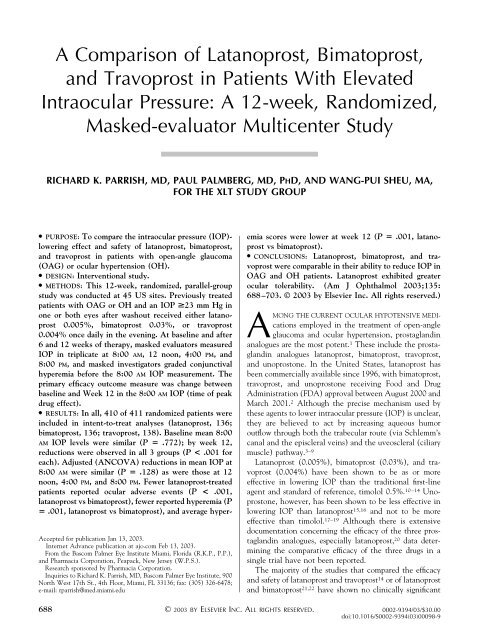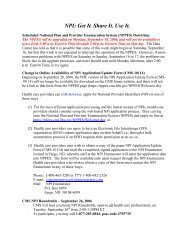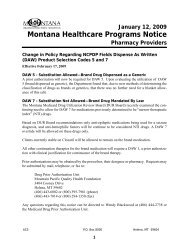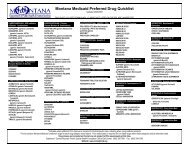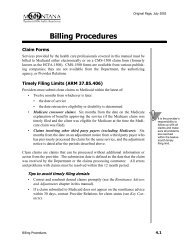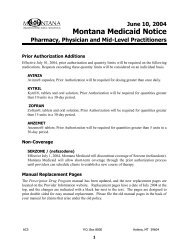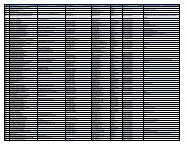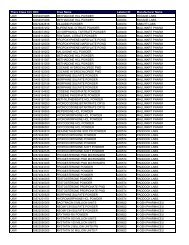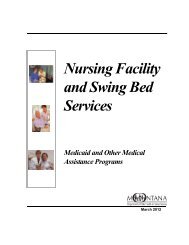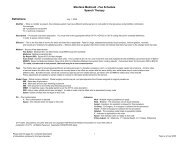A Comparison of Latanoprost, Bimatoprost, and Travoprost in ...
A Comparison of Latanoprost, Bimatoprost, and Travoprost in ...
A Comparison of Latanoprost, Bimatoprost, and Travoprost in ...
You also want an ePaper? Increase the reach of your titles
YUMPU automatically turns print PDFs into web optimized ePapers that Google loves.
A <strong>Comparison</strong> <strong>of</strong> <strong>Latanoprost</strong>, <strong>Bimatoprost</strong>,<br />
<strong>and</strong> <strong>Travoprost</strong> <strong>in</strong> Patients With Elevated<br />
Intraocular Pressure: A 12-week, R<strong>and</strong>omized,<br />
Masked-evaluator Multicenter Study<br />
RICHARD K. PARRISH, MD, PAUL PALMBERG, MD, PHD, AND WANG-PUI SHEU, MA,<br />
FOR THE XLT STUDY GROUP<br />
● PURPOSE: To compare the <strong>in</strong>traocular pressure (IOP)lower<strong>in</strong>g<br />
effect <strong>and</strong> safety <strong>of</strong> latanoprost, bimatoprost,<br />
<strong>and</strong> travoprost <strong>in</strong> patients with open-angle glaucoma<br />
(OAG) or ocular hypertension (OH).<br />
● DESIGN: Interventional study.<br />
● METHODS: This 12-week, r<strong>and</strong>omized, parallel-group<br />
study was conducted at 45 US sites. Previously treated<br />
patients with OAG or OH <strong>and</strong> an IOP >23 mm Hg <strong>in</strong><br />
one or both eyes after washout received either latanoprost<br />
0.005%, bimatoprost 0.03%, or travoprost<br />
0.004% once daily <strong>in</strong> the even<strong>in</strong>g. At basel<strong>in</strong>e <strong>and</strong> after<br />
6 <strong>and</strong> 12 weeks <strong>of</strong> therapy, masked evaluators measured<br />
IOP <strong>in</strong> triplicate at 8:00 AM, 12 noon, 4:00 PM, <strong>and</strong><br />
8:00 PM, <strong>and</strong> masked <strong>in</strong>vestigators graded conjunctival<br />
hyperemia before the 8:00 AM IOP measurement. The<br />
primary efficacy outcome measure was change between<br />
basel<strong>in</strong>e <strong>and</strong> Week 12 <strong>in</strong> the 8:00 AM IOP (time <strong>of</strong> peak<br />
drug effect).<br />
● RESULTS: In all, 410 <strong>of</strong> 411 r<strong>and</strong>omized patients were<br />
<strong>in</strong>cluded <strong>in</strong> <strong>in</strong>tent-to-treat analyses (latanoprost, 136;<br />
bimatoprost, 136; travoprost, 138). Basel<strong>in</strong>e mean 8:00<br />
AM IOP levels were similar (P � .772); by week 12,<br />
reductions were observed <strong>in</strong> all 3 groups (P < .001 for<br />
each). Adjusted (ANCOVA) reductions <strong>in</strong> mean IOP at<br />
8:00 AM were similar (P � .128) as were those at 12<br />
noon, 4:00 PM, <strong>and</strong> 8:00 PM. Fewer latanoprost-treated<br />
patients reported ocular adverse events (P < .001,<br />
latanoprost vs bimatoprost), fewer reported hyperemia (P<br />
� .001, latanoprost vs bimatoprost), <strong>and</strong> average hyper-<br />
Accepted for publication Jan 13, 2003.<br />
Internet Advance publication at ajo.com Feb 13, 2003.<br />
From the Bascom Palmer Eye Institute Miami, Florida (R.K.P., P.P.),<br />
<strong>and</strong> Pharmacia Corporation, Peapack, New Jersey (W.P.S.).<br />
Research sponsored by Pharmacia Corporation.<br />
Inquiries to Richard K. Parrish, MD, Bascom Palmer Eye Institute, 900<br />
North West 17th St., 4th Floor, Miami, FL 33136; fax: (305) 326-6478;<br />
e-mail: rparrish@med.miami.edu<br />
emia scores were lower at week 12 (P � .001, latanoprost<br />
vs bimatoprost).<br />
● CONCLUSIONS: <strong>Latanoprost</strong>, bimatoprost, <strong>and</strong> travoprost<br />
were comparable <strong>in</strong> their ability to reduce IOP <strong>in</strong><br />
OAG <strong>and</strong> OH patients. <strong>Latanoprost</strong> exhibited greater<br />
ocular tolerability. (Am J Ophthalmol 2003;135:<br />
688–703. © 2003 by Elsevier Inc. All rights reserved.)<br />
AMONG THE CURRENT OCULAR HYPOTENSIVE MEDIcations<br />
employed <strong>in</strong> the treatment <strong>of</strong> open-angle<br />
glaucoma <strong>and</strong> ocular hypertension, prostagl<strong>and</strong><strong>in</strong><br />
analogues are the most potent. 1 These <strong>in</strong>clude the prostagl<strong>and</strong><strong>in</strong><br />
analogues latanoprost, bimatoprost, travoprost,<br />
<strong>and</strong> unoprostone. In the United States, latanoprost has<br />
been commercially available s<strong>in</strong>ce 1996, with bimatoprost,<br />
travoprost, <strong>and</strong> unoprostone receiv<strong>in</strong>g Food <strong>and</strong> Drug<br />
Adm<strong>in</strong>istration (FDA) approval between August 2000 <strong>and</strong><br />
March 2001. 2 Although the precise mechanism used by<br />
these agents to lower <strong>in</strong>traocular pressure (IOP) is unclear,<br />
they are believed to act by <strong>in</strong>creas<strong>in</strong>g aqueous humor<br />
outflow through both the trabecular route (via Schlemm’s<br />
canal <strong>and</strong> the episcleral ve<strong>in</strong>s) <strong>and</strong> the uveoscleral (ciliary<br />
muscle) pathway. 3–9<br />
<strong>Latanoprost</strong> (0.005%), bimatoprost (0.03%), <strong>and</strong> travoprost<br />
(0.004%) have been shown to be as or more<br />
effective <strong>in</strong> lower<strong>in</strong>g IOP than the traditional first-l<strong>in</strong>e<br />
agent <strong>and</strong> st<strong>and</strong>ard <strong>of</strong> reference, timolol 0.5%. 10–14 Unoprostone,<br />
however, has been shown to be less effective <strong>in</strong><br />
lower<strong>in</strong>g IOP than latanoprost 15,16 <strong>and</strong> not to be more<br />
effective than timolol. 17–19 Although there is extensive<br />
documentation concern<strong>in</strong>g the efficacy <strong>of</strong> the three prostagl<strong>and</strong><strong>in</strong><br />
analogues, especially latanoprost, 20 data determ<strong>in</strong><strong>in</strong>g<br />
the comparative efficacy <strong>of</strong> the three drugs <strong>in</strong> a<br />
s<strong>in</strong>gle trial have not been reported.<br />
The majority <strong>of</strong> the studies that compared the efficacy<br />
<strong>and</strong> safety <strong>of</strong> latanoprost <strong>and</strong> travoprost 14 or <strong>of</strong> latanoprost<br />
<strong>and</strong> bimatoprost 21,22 have shown no cl<strong>in</strong>ically significant<br />
© 2003 BY ELSEVIER INC. ALL RIGHTS RESERVED.<br />
688 0002-9394/03/$30.00<br />
doi:10.1016/S0002-9394(03)00098-9
differences <strong>in</strong> the IOP-lower<strong>in</strong>g ability <strong>of</strong> these medications<br />
at 8 AM, the time <strong>of</strong> peak effect, <strong>and</strong> differences at<br />
other time po<strong>in</strong>ts may have been confounded by basel<strong>in</strong>e<br />
differences. The exception was a recent <strong>in</strong>vestigation 23<br />
suggest<strong>in</strong>g that bimatoprost may be more effective than<br />
latanoprost <strong>in</strong> reduc<strong>in</strong>g IOP levels. Less open to debate has<br />
been the relative frequency <strong>of</strong> several ocular adverse<br />
events, most notably ocular hyperemia, which may affect<br />
patient compliance <strong>and</strong> thus the overall effectiveness <strong>of</strong><br />
the topical prostagl<strong>and</strong><strong>in</strong> analogues. Compared to latanoprost,<br />
both bimatoprost <strong>and</strong> travoprost have been shown to<br />
have substantially higher rates <strong>of</strong> ocular side effects. 14,22<br />
The present trial is the first to compare simultaneously the<br />
cl<strong>in</strong>ical outcomes associated with the use <strong>of</strong> latanoprost,<br />
bimatoprost, <strong>and</strong> travoprost.<br />
METHODS<br />
● SETTING: This 12-week, r<strong>and</strong>omized, parallel-group,<br />
masked-evaluator study conducted at 45 sites <strong>in</strong> the<br />
United States compared the efficacy <strong>and</strong> safety <strong>of</strong> once<br />
daily adm<strong>in</strong>istration <strong>of</strong> three commercially available prostagl<strong>and</strong><strong>in</strong><br />
analogues: latanoprost 0.005%, bimatoprost<br />
0.03%, <strong>and</strong> travoprost 0.004% ophthalmic solutions. Regulatory<br />
authorities at each study site reviewed <strong>and</strong> approved<br />
the protocol <strong>in</strong> accordance with guidel<strong>in</strong>es for the<br />
conduct <strong>of</strong> cl<strong>in</strong>ical research conta<strong>in</strong>ed <strong>in</strong> the 1964 Declaration<br />
<strong>of</strong> Hels<strong>in</strong>ki.<br />
● PATIENTS: Patients were eligible for participation if<br />
they met the follow<strong>in</strong>g <strong>in</strong>clusion criteria: age � 18 years;<br />
bilateral or unilateral primary open-angle glaucoma, exfoliative<br />
glaucoma, pigmentary glaucoma, or ocular hypertension<br />
(IOP � 21 mm Hg at diagnosis); current or<br />
previous (with<strong>in</strong> the past 6 months) monotherapy or dual<br />
therapy with a topical ocular hypotensive agent(s); bestcorrected<br />
visual acuity equal to or better than 20/200; <strong>and</strong><br />
ability to comply with the requirements <strong>of</strong> the study<br />
protocol. All patients provided signed <strong>in</strong>formed consent<br />
prior to study enrollment.<br />
Exclusion criteria were known hypersensitivity to any<br />
component <strong>in</strong> the study medications; use <strong>of</strong> any medication<br />
known to affect IOP unless both patient <strong>and</strong> dosage<br />
were stable with<strong>in</strong> the previous 3 months <strong>and</strong> no change <strong>in</strong><br />
dosage was expected dur<strong>in</strong>g the study; use <strong>of</strong> any <strong>in</strong>vestigational<br />
medications with<strong>in</strong> 30 days <strong>of</strong> the screen<strong>in</strong>g visit;<br />
history <strong>of</strong> acute angle-closure or closed or slit open anterior<br />
chamber angle; argon laser trabeculoplasty or other ocular<br />
(globe) surgery with<strong>in</strong> the previous 3 months or any<br />
previous filter<strong>in</strong>g surgery (an unlasered or unfiltered eye<br />
could be enrolled as the study eye); ocular <strong>in</strong>fection or<br />
<strong>in</strong>flammation with<strong>in</strong> the previous 3 months; <strong>and</strong> pregnancy,<br />
lactation, or <strong>in</strong>adequate contraception.<br />
● TREATMENT PROTOCOL: A screen<strong>in</strong>g visit exam<strong>in</strong>ation<br />
for all patients (up to 1 month prior to the basel<strong>in</strong>e<br />
visit) <strong>in</strong>cluded a review <strong>of</strong> ocular <strong>and</strong> medical history, IOP<br />
measurement with a calibrated Goldmann applanation<br />
tonometer, Snellen visual acuity measurement, slit-lamp<br />
biomicroscopy, ophthalmoscopy, <strong>and</strong> visual field test<strong>in</strong>g<br />
(automated perimetry) if not done with<strong>in</strong> the past 12<br />
months. Patients deemed eligible for the study were removed<br />
from all ocular hypotensive therapy at this time.<br />
Required washout periods prior to the basel<strong>in</strong>e visit were 5<br />
days for chol<strong>in</strong>ergic agonists <strong>and</strong> carbonic anhydrase <strong>in</strong>hibitors;<br />
2 weeks for adrenergic agonists; <strong>and</strong> 4 weeks for<br />
�-adrenergic receptor antagonists <strong>and</strong> prostagl<strong>and</strong><strong>in</strong> analogues.<br />
For all patients previously us<strong>in</strong>g �-adrenergic receptor<br />
antagonists <strong>and</strong> prostagl<strong>and</strong><strong>in</strong> analogues, IOP<br />
measurement was required as a safety check after 2 weeks<br />
<strong>of</strong> washout; observed IOP levels considered potentially<br />
hazardous resulted <strong>in</strong> patients be<strong>in</strong>g excluded from the<br />
study.<br />
Study visits occurred at basel<strong>in</strong>e <strong>and</strong> after 2, 6, <strong>and</strong> 12<br />
weeks <strong>of</strong> therapy. At the basel<strong>in</strong>e visit, which followed the<br />
washout period, masked evaluators performed three IOP<br />
measurements <strong>in</strong> each eye, alternat<strong>in</strong>g between eyes, <strong>and</strong><br />
start<strong>in</strong>g with the right eye at 8:00 AM, 12 noon, 4:00 PM,<br />
<strong>and</strong> 8:00 PM. The mean <strong>of</strong> these IOP measurements at each<br />
time po<strong>in</strong>t was used <strong>in</strong> statistical analyses. Either one or<br />
both eyes <strong>of</strong> a patient could be enrolled as study eyes. An<br />
eye was eligible if the mean IOP was �23 mm Hg at the<br />
8:00 AM basel<strong>in</strong>e measurement. For patients hav<strong>in</strong>g both<br />
eyes enrolled, the mean <strong>of</strong> the IOP read<strong>in</strong>gs <strong>in</strong> both eyes<br />
was used as the patient’s IOP <strong>in</strong> the analyses. In patients<br />
with bilateral disease with only one eye that met all<br />
eligibility criteria (study eye), the other eye also could be<br />
treated with study drug provided that no exclusion criteria<br />
existed for that eye. If both eyes met all eligibility criteria,<br />
both were enrolled as study eyes.<br />
Study medications were packaged <strong>in</strong> commercially available<br />
labeled conta<strong>in</strong>ers manufactured by Pharmacia Corporation<br />
(latanoprost), Allergan (bimatoprost), <strong>and</strong> Alcon<br />
Laboratories (travoprost). To preserve mask<strong>in</strong>g, each conta<strong>in</strong>er<br />
was overpackaged <strong>in</strong> an opaque black vial <strong>and</strong> then<br />
sealed <strong>in</strong> a patient kit with tamper-evident strips; the name<br />
<strong>of</strong> the drug was not <strong>in</strong>cluded on kit labels. A designated,<br />
unmasked coord<strong>in</strong>ator (who did not perform any study<br />
evaluations or assessments) at each study center received<br />
r<strong>and</strong>omization codes <strong>and</strong> prepackaged cl<strong>in</strong>ical supplies<br />
from Pharmacia Cl<strong>in</strong>ical Supply Logistics (Kalamazoo,<br />
Michigan, USA), <strong>and</strong> dispensed the medication kits. The<br />
coord<strong>in</strong>ator was responsible for stor<strong>in</strong>g each medication kit<br />
accord<strong>in</strong>g to its respective product package <strong>in</strong>sert.<br />
Follow<strong>in</strong>g the 8:00 PM basel<strong>in</strong>e measurement, eligible<br />
patients were r<strong>and</strong>omly assigned with<strong>in</strong> each study center<br />
to one <strong>of</strong> three treatment groups <strong>in</strong> a 1:1:1 ratio: latanoprost<br />
0.005%, bimatoprost 0.03%, or travoprost 0.004%.<br />
One patient medication kit was dispensed to each eligible<br />
patient at the basel<strong>in</strong>e visit <strong>and</strong> another at the week 6<br />
VOL. 135, NO. 5 COMPARING LATANOPROST, BIMATOPROST, AND TRAVOPROST<br />
689
FIGURE 1. St<strong>and</strong>ard photographs used to assess grades <strong>of</strong> conjunctival hyperemia.<br />
visit; patients were <strong>in</strong>structed to return all study medications<br />
at week 12 or at the f<strong>in</strong>al visit for those discont<strong>in</strong>u<strong>in</strong>g<br />
the study early. Patients were rem<strong>in</strong>ded to change study<br />
medication bottles every 4 weeks. Each medication was to<br />
be <strong>in</strong>stilled daily at 8:00 PM, <strong>and</strong> no other IOP-reduc<strong>in</strong>g<br />
therapy was permitted. Instillation <strong>of</strong> study medication<br />
began on the even<strong>in</strong>g <strong>of</strong> the basel<strong>in</strong>e visit. Physician<br />
<strong>in</strong>vestigators (hereafter called <strong>in</strong>vestigators) <strong>and</strong> evaluators<br />
rema<strong>in</strong>ed masked to treatment throughout the study;<br />
patients were the only ones aware <strong>of</strong> their treatment<br />
assignments <strong>and</strong> were cautioned not to reveal the treatment<br />
assignment to masked study-site personnel. At weeks<br />
2, 6, <strong>and</strong> 12, <strong>in</strong>vestigators noted on the case report form<br />
whether or not mask<strong>in</strong>g had been ma<strong>in</strong>ta<strong>in</strong>ed. The statistician<br />
also was masked until the database was closed.<br />
Intraocular pressure was measured at any time dur<strong>in</strong>g the<br />
day at week 2 <strong>and</strong> at 8:00 AM, 12 noon, 4:00 PM, <strong>and</strong> 8:00<br />
PM at weeks 6 <strong>and</strong> 12 (or at time <strong>of</strong> earlier discont<strong>in</strong>uation).<br />
As at basel<strong>in</strong>e, masked evaluators performed three<br />
IOP measurements <strong>in</strong> each eye, alternat<strong>in</strong>g between eyes,<br />
<strong>and</strong> start<strong>in</strong>g with the right eye at each specified time po<strong>in</strong>t.<br />
At weeks 6 <strong>and</strong> 12, patients were questioned to ensure that<br />
the last eyedrop was adm<strong>in</strong>istered the even<strong>in</strong>g before the<br />
visit. The mean <strong>of</strong> the three IOP measures for each eye at<br />
each time po<strong>in</strong>t was used <strong>in</strong> statistical analyses.<br />
At basel<strong>in</strong>e <strong>and</strong> weeks 6 <strong>and</strong> 12, an <strong>in</strong>vestigator masked<br />
to treatment completed a conjunctival hyperemia grad<strong>in</strong>g<br />
scale before the 8:00 AM IOP measurement; at week 2,<br />
grad<strong>in</strong>g was performed prior to tonometry. The presence<br />
<strong>and</strong> severity <strong>of</strong> hyperemia were assessed by the method<br />
used <strong>in</strong> several phase 3 registration trials. 10–12 Each eye was<br />
compared with st<strong>and</strong>ard photographs show<strong>in</strong>g conjunctival<br />
hyperemia <strong>of</strong> grades 0, 1, 2, <strong>and</strong> 3 (none, mild,<br />
moderate, <strong>and</strong> severe, respectively) (Figure 1); the scale<br />
<strong>in</strong>cluded values <strong>of</strong> 0, 0.5, 1.0, 1.5, 2.0, 2.5, <strong>and</strong> 3.0. In<br />
addition, at every visit, the same <strong>in</strong>vestigator asked patients<br />
whether they or anyone else had noticed any redness<br />
<strong>in</strong> his or her eye(s) s<strong>in</strong>ce the last visit <strong>and</strong>, if so, to what<br />
extent they were bothered by such redness. Extent <strong>of</strong><br />
symptom was graded with the follow<strong>in</strong>g responses: not at<br />
all, a small amount, a moderate amount, or a great amount.<br />
Investigators recorded patients’ responses.<br />
Throughout the study, any undesired medical occurrence<br />
regardless <strong>of</strong> relationship to treatment was considered<br />
an adverse event <strong>and</strong> was monitored. Def<strong>in</strong>ed criteria<br />
were used to grade the <strong>in</strong>tensity <strong>of</strong> each adverse event <strong>and</strong><br />
to classify the event as serious or nonserious. Any adverse<br />
event considered serious, related to study medication <strong>and</strong><br />
persistent, or any ocular adverse event present at the end<br />
<strong>of</strong> study treatment (week 12) resulted <strong>in</strong> patients be<strong>in</strong>g<br />
followed up for 2 weeks after the f<strong>in</strong>al visit. Follow-up <strong>of</strong><br />
serious adverse events considered to be related to a study<br />
medication cont<strong>in</strong>ued until events were resolved or<br />
deemed chronic or stable.<br />
● MAIN OUTCOME MEASURES AND ANALYSES: The<br />
Fisher least significant difference procedure was used to<br />
compare treatment groups. 24 Cont<strong>in</strong>uous variables were<br />
tested for treatment group differences us<strong>in</strong>g one-way analysis<br />
<strong>of</strong> variance (ANOVA) with treatment (latanoprost,<br />
bimatoprost, or travoprost) as the <strong>in</strong>dependent variable. If<br />
the overall treatment effect was not significant (P � .05),<br />
it was concluded that no difference existed between<br />
treatment means. If the overall treatment effect was<br />
significant (P � .05), pairwise comparisons <strong>of</strong> treatment<br />
means were performed us<strong>in</strong>g t tests, with the significance <strong>of</strong><br />
each set at the .05 level.<br />
The primary efficacy outcome, mean change between<br />
basel<strong>in</strong>e <strong>and</strong> week 12 <strong>in</strong> IOP measurements obta<strong>in</strong>ed at<br />
8:00 AM (time <strong>of</strong> peak drug effect), was analyzed us<strong>in</strong>g the<br />
above procedure, but with the analysis <strong>of</strong> covariance model<br />
(ANCOVA), with basel<strong>in</strong>e IOP as the covariate <strong>and</strong><br />
treatment <strong>and</strong> center as factors. If the overall treatment<br />
effect was significant, pairwise comparisons <strong>of</strong> treatment<br />
means were performed us<strong>in</strong>g contrasts. The 95% confidence<br />
<strong>in</strong>terval (CI) <strong>of</strong> the difference <strong>in</strong> the mean change<br />
was calculated based on the ANCOVA model. This<br />
procedure also was applied to the secondary outcomes,<br />
690 AMERICAN JOURNAL OF OPHTHALMOLOGY<br />
MAY 2003
FIGURE 2. Flow diagram <strong>of</strong> patient disposition. IOP � <strong>in</strong>traocular pressure; ITT � <strong>in</strong>tent-to-treat.<br />
mean change between basel<strong>in</strong>e <strong>and</strong> week 12 <strong>in</strong> IOP<br />
measurements obta<strong>in</strong>ed at 12 noon, 4:00 PM, <strong>and</strong> 8:00 PM<br />
(time <strong>of</strong> trough), <strong>and</strong> <strong>in</strong> diurnal IOP, which was def<strong>in</strong>ed as<br />
the mean <strong>of</strong> IOP measurements at 8:00 AM, 12 noon, 4:00<br />
PM, <strong>and</strong> 8:00 PM. With<strong>in</strong>-treatment group IOP changes<br />
were tested with paired t tests. Categorical variables are<br />
presented <strong>in</strong> cont<strong>in</strong>gency tables with counts <strong>and</strong> percentages,<br />
<strong>and</strong> a Fisher exact test or chi-square test was used to<br />
test for treatment group differences. All statistical tests<br />
were two-tailed <strong>and</strong> were performed at the .05 significance<br />
level.<br />
Racial differences <strong>in</strong> treatment response also were analyzed<br />
us<strong>in</strong>g the ANCOVA model, with change from<br />
basel<strong>in</strong>e to week 12 <strong>in</strong> 8:00 AM IOP as the dependent<br />
(outcome) variable, basel<strong>in</strong>e 8:00 AM IOP as the covariate,<br />
<strong>and</strong> treatment, center, race, <strong>and</strong> treatment-by-race <strong>in</strong>teraction<br />
as other factors. Race was categorized as Caucasian,<br />
black, <strong>and</strong> other for this analysis. A similar analysis was<br />
conducted on IOP change between basel<strong>in</strong>e <strong>and</strong> week 12<br />
<strong>in</strong> 8:00 PM IOP.<br />
Separate <strong>and</strong> parallel efficacy analyses <strong>of</strong> both <strong>in</strong>tent-totreat<br />
(ITT) <strong>and</strong> per-protocol populations were conducted.<br />
All efficacy analyses were based on study eye(s). The ITT<br />
analyses <strong>in</strong>cluded all r<strong>and</strong>omized patients who had at least<br />
one valid IOP evaluation after beg<strong>in</strong>n<strong>in</strong>g treatment with<br />
study medication. For ITT analyses, miss<strong>in</strong>g IOP measurements<br />
at week 12 were obta<strong>in</strong>ed by carry<strong>in</strong>g forward the<br />
correspond<strong>in</strong>g week 6 measurements. Diurnal IOP then<br />
was calculated based on available measurements. If no<br />
measurement was available, the diurnal measurement at<br />
the previous visit was carried forward. Miss<strong>in</strong>g values at<br />
week 6 were imputed us<strong>in</strong>g week 2 data. Although 2.1% <strong>of</strong><br />
the 5,330 expected IOP observations were miss<strong>in</strong>g, perprotocol<br />
analyses that excluded patients who did not<br />
complete the study or who had major protocol violations<br />
also were conducted to confirm ITT results. Those analyses<br />
<strong>in</strong>cluded all patients who completed the full course <strong>of</strong><br />
treatment without a major violation <strong>of</strong> protocol guidel<strong>in</strong>es;<br />
no miss<strong>in</strong>g data were imputed for the per-protocol analyses.<br />
Safety analyses <strong>in</strong>cluded all r<strong>and</strong>omized patients (safety<br />
population). The Medical Dictionary for Regulatory Activities<br />
(MedDRA) cod<strong>in</strong>g system was used to classify<br />
adverse events. Frequencies <strong>of</strong> ocular <strong>and</strong> systemic adverse<br />
events <strong>and</strong> numbers <strong>of</strong> patients affected were summarized<br />
by treatment group. Ocular adverse events <strong>and</strong> hyperemia<br />
events (MedDRA preferred terms: ocular hyperemia, red<br />
eye, conjunctival vascular disorder not otherwise specified,<br />
<strong>and</strong> conjunctivitis not elsewhere classified) also were<br />
summarized by maximum <strong>in</strong>tensity. Masked <strong>in</strong>vestigators’<br />
<strong>and</strong> patients’ assessments <strong>of</strong> hyperemia were summarized by<br />
treatment <strong>and</strong> visit <strong>and</strong> were tested for treatment differences.<br />
Each patient’s hyperemia score was calculated by<br />
tak<strong>in</strong>g the mean <strong>of</strong> the hyperemia scores <strong>of</strong> the patient’s<br />
treated eyes. Other safety variables, such as visual acuity,<br />
VOL. 135, NO. 5 COMPARING LATANOPROST, BIMATOPROST, AND TRAVOPROST<br />
691
FIGURE 3. Frequencies <strong>of</strong> patients receiv<strong>in</strong>g <strong>in</strong>traocular pressure (IOP)-reduc<strong>in</strong>g medication at screen<strong>in</strong>g (<strong>in</strong>tent-to-treat<br />
population). Some patients were tak<strong>in</strong>g dual therapy.<br />
changes after treatment <strong>in</strong> the lid <strong>and</strong> slit-lamp exam<strong>in</strong>ation,<br />
<strong>and</strong> ophthalmoscopy results, also were tabulated.<br />
Before the study, it was determ<strong>in</strong>ed that a sample <strong>of</strong> at<br />
least 113 patients capable <strong>of</strong> be<strong>in</strong>g evaluated per treatment<br />
group was required to detect a difference <strong>of</strong> 1.5 mm Hg <strong>in</strong><br />
mean IOP reduction between the two treatment groups at<br />
a significance level <strong>of</strong> .05, with a power <strong>of</strong> .80 <strong>and</strong><br />
assum<strong>in</strong>g a st<strong>and</strong>ard deviation (SD) <strong>of</strong> 4.0 mm Hg. The<br />
plan was to <strong>in</strong>clude a m<strong>in</strong>imum <strong>of</strong> 375 patients so as to<br />
allow for patient withdrawals.<br />
RESULTS<br />
● PATIENT DISPOSITION AND DEMOGRAPHICS: In all,<br />
514 patients were screened; 1 patient was excluded at the<br />
week 2 safety check because <strong>of</strong> an elevated IOP. Follow<strong>in</strong>g<br />
enrollment at basel<strong>in</strong>e, 411 patients were r<strong>and</strong>omized to<br />
three treatment groups: latanoprost (n � 136), bimatoprost<br />
(n � 137), <strong>and</strong> travoprost (n � 138) (Figure 2). One<br />
patient <strong>in</strong> the bimatoprost group received medication but<br />
had no postbasel<strong>in</strong>e evaluation <strong>and</strong> was excluded from ITT<br />
analyses. The result<strong>in</strong>g ITT population comprised 410<br />
patients <strong>of</strong> whom 172 (42.0%) were male, 229 (55.9%)<br />
were Caucasian, <strong>and</strong> 125 (30.5%) were African American.<br />
Diagnoses <strong>in</strong>cluded primary open-angle glaucoma <strong>in</strong> 309/<br />
410 (75.4%) patients, ocular hypertension <strong>in</strong> 95/410<br />
(23.2%) patients, <strong>and</strong> exfoliative or pigmentary glaucoma<br />
<strong>in</strong> 5/410 (1.2%) patients; 1 patient had none <strong>of</strong> the listed<br />
diagnoses. Study participants had a mean age <strong>of</strong> 65 years.<br />
At screen<strong>in</strong>g, the latanoprost, bimatoprost, <strong>and</strong> travoprost<br />
ITT groups had similar proportions <strong>of</strong> patients tak<strong>in</strong>g a<br />
prostagl<strong>and</strong><strong>in</strong> analogue (52.9%, 49.6%, <strong>and</strong> 47.1%, respectively)<br />
(Figure 3), <strong>and</strong> those tak<strong>in</strong>g a prostagl<strong>and</strong><strong>in</strong> had<br />
similar mean IOP levels (19.4 mm Hg, 19.6 mm Hg, <strong>and</strong><br />
19.9 mm Hg, respectively) (Figure 4). Demographic <strong>and</strong><br />
basel<strong>in</strong>e characteristics were generally similar across treatment<br />
groups with no statistically significant differences<br />
found (Table 1). Overall, 98/136 (72.1%) <strong>of</strong> latanoprosttreated<br />
patients, 96/136 (70.6%) patients receiv<strong>in</strong>g bimatoprost,<br />
<strong>and</strong> 79/138 (57.2%) <strong>of</strong> those treated with<br />
travoprost had both eyes as study eyes, <strong>and</strong> 400/410<br />
(97.6%) patients received assigned study medication <strong>in</strong><br />
both eyes (one eye <strong>of</strong> which may not have been a study<br />
692 AMERICAN JOURNAL OF OPHTHALMOLOGY<br />
MAY 2003
FIGURE 4. Mean <strong>in</strong>traocular pressure (IOP) at screen<strong>in</strong>g by IOP-reduc<strong>in</strong>g medication (<strong>in</strong>tent-to-treat population). Some patients<br />
were tak<strong>in</strong>g dual therapy.<br />
eye). Of the 393/411 patients (95.6%) who completed the<br />
study, the average exposure to study medication was 86<br />
days, <strong>in</strong>clud<strong>in</strong>g the basel<strong>in</strong>e day.<br />
Unmask<strong>in</strong>g occurred <strong>in</strong> 6 patients (latanoprost, n � 3;<br />
bimatoprost, n � 1; travoprost, n � 2); <strong>in</strong> 3 <strong>of</strong> these cases,<br />
the technician was unmasked but the <strong>in</strong>vestigator was not.<br />
In all, 28/410 (6.8%) patients (latanoprost, n � 10;<br />
bimatoprost, n � 9; travoprost, n � 9) <strong>in</strong>cluded <strong>in</strong> ITT<br />
analyses were excluded from per-protocol evaluations ow<strong>in</strong>g<br />
to major protocol deviations, early term<strong>in</strong>ation from<br />
the study, or both (Figure 2). Demographic characteristics<br />
<strong>and</strong> efficacy results <strong>of</strong> primary <strong>and</strong> secondary endpo<strong>in</strong>ts<br />
were similar <strong>in</strong> ITT <strong>and</strong> per-protocol populations.<br />
● EFFICACY RESULTS: At basel<strong>in</strong>e, mean IOP levels<br />
were similar across groups at each time po<strong>in</strong>t <strong>and</strong> for the<br />
diurnal measurement (Table 2; Figures 5 <strong>and</strong> 6). With<br />
regard to the primary efficacy variable, mean 8:00 AM IOP<br />
levels at basel<strong>in</strong>e were 25.7 mm Hg <strong>in</strong> the latanoprost<br />
group, 25.7 mm Hg <strong>in</strong> the bimatoprost group, <strong>and</strong> 25.5 mm<br />
Hg <strong>in</strong> the travoprost group (P � .772). By week 12,<br />
significant (P � .001) reductions were observed <strong>in</strong> all three<br />
treatment groups. The estimated mean � SEM IOP<br />
reduction (ANCOVA) was 8.6 � 0.3 mm Hg for those<br />
treated with latanoprost, 8.7 � 0.3 mm Hg for bimatoprost-treated<br />
patients, <strong>and</strong> 8.0 � 0.3 mm Hg for patients<br />
receiv<strong>in</strong>g travoprost (P � .128 for difference among<br />
groups). Adjusted differences (see Methods) <strong>in</strong> mean IOP<br />
reductions at 8:00 AM also showed equivalence among<br />
treatments when latanoprost was compared with either<br />
bimatoprost (latanoprost versus bimatoprost: �0.13 mm<br />
Hg; 95% CI �0.84, 0.58) or with travoprost (latanoprost<br />
vs travoprost: 0.56 mm Hg; 95% CI �0.15, 1.26) <strong>and</strong><br />
when bimatoprost was compared with travoprost (bimatoprost<br />
vs travoprost: 0.69 mm Hg; 95% CI �0.02, 1.40).<br />
The distributions <strong>of</strong> changes <strong>in</strong> IOP levels for the<br />
primary efficacy variable for each treatment group are<br />
given <strong>in</strong> Figure 7. Inspection <strong>of</strong> the distributions reveals<br />
quite similar box plots. Subgroup analyses for each treatment<br />
group, stratified by previous use or nonuse <strong>of</strong> a<br />
prostagl<strong>and</strong><strong>in</strong> analogue (Figure 8A) or by the occurrence<br />
or nonoccurrence <strong>of</strong> <strong>in</strong>vestigator-noted hyperemia (Figure<br />
8B), similarly do not reveal differences.<br />
Results <strong>of</strong> per-protocol analyses <strong>of</strong> changes from basel<strong>in</strong>e<br />
to week 12 <strong>in</strong> mean IOP levels at 8:00 AM generally were<br />
supportive <strong>of</strong> those <strong>of</strong> ITT evaluations, although the<br />
overall treatment difference was significant (P � .029,<br />
ANCOVA). Adjusted differences (see Methods) <strong>in</strong> mean<br />
IOP reductions at 8:00 AM showed comparability between<br />
latanoprost <strong>and</strong> either bimatoprost (�0.22 mm Hg; 95%<br />
CI �0.94, 0.50) or travoprost (0.71 mm Hg; 95% CI<br />
�0.01, 1.42), but IOP levels were reduced more <strong>in</strong><br />
bimatoprost-treated than <strong>in</strong> travoprost-treated patients<br />
(0.93 mm Hg; 95% CI 0.22, 1.65).<br />
Mean IOP levels at week 12 were similar across treatment<br />
groups at all time po<strong>in</strong>ts (Figure 6). The ITT analyses<br />
VOL. 135, NO. 5 COMPARING LATANOPROST, BIMATOPROST, AND TRAVOPROST<br />
693
evealed no significant differences among treatment groups<br />
<strong>in</strong> adjusted mean IOP reductions from basel<strong>in</strong>e to week 12<br />
at 12 noon, 4:00 PM, or 8:00 PM (P � .075, P � .057, <strong>and</strong><br />
P � .100, respectively). Also, no significant difference<br />
existed across treatments <strong>in</strong> changes <strong>in</strong> mean diurnal IOP<br />
levels measured at week 12 (P � .125); distributions <strong>of</strong><br />
TABLE 1. Demographic Data (Intent-to-Treat Population)<br />
<strong>Latanoprost</strong> <strong>Bimatoprost</strong> <strong>Travoprost</strong><br />
(n � 136) (n � 136) (n � 138)<br />
n(%) n(%) n(%)<br />
Gender<br />
Male<br />
Age (year)<br />
60 (44.1) 52 (38.2) 60 (43.5)<br />
Mean (SD) 65.9 (11.27) 64.4 (12.35) 65.6 (10.81)<br />
Range<br />
Ethnic orig<strong>in</strong><br />
28–90 29–85 26–82<br />
Caucasian 72 (52.9) 74 (54.4) 83 (60.1)<br />
African American 40 (29.4) 45 (33.1) 40 (29.0)<br />
Hispanic 20 (14.7) 12 (8.8) 13 (9.4)<br />
Asian 4 (2.9) 3 (2.2) 2 (1.4)<br />
Other<br />
Eye color<br />
0 2 (1.5) 0<br />
Homogeneously blue, gray, or green 33 (24.3) 35 (25.7) 40 (29.0)<br />
Homogeneously brown 92 (67.6) 88 (64.7) 82 (59.4)<br />
Blue-brown/gray-brown 5 (3.7) 3 (2.2) 4 (2.9)<br />
Green-brown 6 (4.4) 7 (5.1) 9 (6.5)<br />
Yellow-brown<br />
Nevi or freckles (study eye[s])<br />
0 3 (2.2) 3 (2.2)<br />
On iris 22 (16.2) 17 (12.5) 25 (18.1)<br />
On conjunctiva bulbi 12 (8.8) 10 (7.4) 5 (3.6)<br />
On both 2 (1.5) 2 (1.5) 0<br />
Not present<br />
Diagnosis (study eye[s])<br />
100 (73.5) 107 (78.7) 108 (78.3)<br />
Primary open-angle glaucoma 105 (77.2) 103 (75.7) 101 (73.2)<br />
Pigmentary glaucoma 1 (0.7) 1 (0.7) 1 (0.7)<br />
Exfoliative glaucoma 1 (0.7) 1 (0.7) 0<br />
Ocular hypertension 29 (21.3) 31 (22.8) 35 (25.4)<br />
None <strong>of</strong> listed diagnoses<br />
Duration <strong>of</strong> condition (study eye[s])<br />
0 0 1 (0.7)<br />
�6 months 12 (8.8) 6 (4.4) 10 (7.2)<br />
�6 to 36 months 44 (32.4) 35 (25.7) 47 (34.1)<br />
�36 to 120 months 55 (40.4) 72 (52.9) 55 (39.9)<br />
�120 months 25 (18.4) 23 (16.9) 26 (18.8)<br />
Family history <strong>of</strong> glaucoma/ocular hypertension 50 (36.8) 53 (39.0) 58 (42.0)<br />
Visual field—any glaucomatous defect (study eye[s])<br />
Basel<strong>in</strong>e IOP-lower<strong>in</strong>g medications*<br />
70 (51.5) 66 (48.5) 63 (45.7)<br />
Prostagl<strong>and</strong><strong>in</strong> analogues 72 (52.9) 68 (50.0) 65 (47.1)<br />
Carbonic anhydrase <strong>in</strong>hibitors 43 (31.6) 44 (32.4) 55 (39.9)<br />
�-Adrenergic receptor antagonists 35 (25.7) 44 (32.4) 37 (26.8)<br />
Adrenergic receptor agonists 16 (11.8) 19 (14.0) 20 (14.5)<br />
Comb<strong>in</strong>ation therapies 5 (3.7) 4 (2.9) 5 (3.6)<br />
Masked <strong>in</strong>vestigational drugs 4 (2.9) 3 (2.2) 3 (2.2)<br />
Chol<strong>in</strong>ergic agonists 3 (2.2) 1 (0.7) 0<br />
IOP � <strong>in</strong>traocular pressure.<br />
*Some patients were receiv<strong>in</strong>g dual therapy at basel<strong>in</strong>e.<br />
diurnal IOP reductions from basel<strong>in</strong>e to week 12 are shown<br />
<strong>in</strong> Figure 7.<br />
In an exploratory analysis, no racial differences <strong>in</strong><br />
patients’ responses to the treatments were observed; however,<br />
the study was not powered to detect subgroup<br />
differences based on race. The ANCOVA model, us<strong>in</strong>g<br />
694 AMERICAN JOURNAL OF OPHTHALMOLOGY<br />
MAY 2003
TABLE 2. Intraocular Pressure (IOP) <strong>and</strong> IOP Reduction From Basel<strong>in</strong>e to Week 12: Unadjusted Mean � SD<br />
(Intent-to-Treat Population)<br />
<strong>Latanoprost</strong><br />
(n � 136)<br />
change <strong>in</strong> IOP between basel<strong>in</strong>e <strong>and</strong> week 12 as the<br />
dependent variable, yielded no evidence for race effect<br />
(P � .439, 8:00 AM; P � .227, 8:00 PM) or treatment by<br />
race effect (P � .681, 8:00 AM; P � .543, 8:00 PM).<br />
● SAFETY RESULTS: At least one adverse event was<br />
reported by 87/136 (64.0%) patients receiv<strong>in</strong>g latanoprost,<br />
IOP (mm Hg) IOP Reduction (mm Hg): Basel<strong>in</strong>e to Week 12<br />
<strong>Bimatoprost</strong><br />
(n � 136)<br />
<strong>Travoprost</strong><br />
(n � 138)<br />
<strong>Latanoprost</strong><br />
(n � 136)<br />
<strong>Bimatoprost</strong><br />
(n � 136)<br />
<strong>Travoprost</strong><br />
(n � 138)<br />
Basel<strong>in</strong>e<br />
8:00 AM 25.7 � 2.8 25.7 � 3.1 25.5 � 2.8<br />
12 noon 23.7 � 3.5 23.8 � 3.4 23.8 � 3.8<br />
4:00 PM 23.0 � 3.6 22.8 � 3.6 22.8 � 3.3<br />
8:00 PM 22.3 � 3.7 22.3 � 3.3 22.0 � 3.4<br />
Diurnal<br />
Week 12<br />
23.7 � 2.9 23.7 � 2.7 23.5 � 2.9<br />
8:00 AM 17.1 � 3.1 17.0 � 3.3 17.6 � 3.7 8.6 � 3.7 8.7 � 3.8 7.9 � 3.4<br />
12 noon 16.5 � 2.7 16.2 � 3.0 16.8 � 3.3 7.2 � 3.9 7.6 � 4.0 6.8 � 3.6<br />
4:00 PM 16.7 � 2.5 16.0 � 2.8 16.4 � 3.4 6.2 � 3.6 6.8 � 4.0 6.3 � 3.8<br />
8:00 PM 16.3 � 2.4 15.8 � 3.0 16.1 � 3.2 5.9 � 3.8 6.5 � 3.4 5.7 � 3.9<br />
Diurnal 16.7 � 2.4 16.4 � 2.8 16.8 � 3.2 7.0 � 3.1 7.3 � 3.2 6.7 � 3.2<br />
FIGURE 5. Unadjusted 8:00 AM mean <strong>in</strong>traocular pressure (IOP) levels by treatment <strong>and</strong> visit (<strong>in</strong>tent-to-treat population).<br />
104/137 (75.9%) <strong>of</strong> those <strong>in</strong> the bimatoprost group, <strong>and</strong><br />
95/138 (68.8%) <strong>of</strong> those treated with travoprost (Table 3).<br />
Fewer latanoprost-treated patients reported an ocular adverse<br />
event compared with those receiv<strong>in</strong>g bimatoprost or<br />
travoprost (P � .003 for difference among the three<br />
treatments; P � .001 for difference between latanoprost<br />
<strong>and</strong> bimatoprost). Compared with latanoprost-treated or<br />
VOL. 135, NO. 5 COMPARING LATANOPROST, BIMATOPROST, AND TRAVOPROST<br />
695
FIGURE 6. Unadjusted mean <strong>in</strong>traocular pressure (IOP) levels by treatment <strong>and</strong> measurement time at basel<strong>in</strong>e <strong>and</strong> week 12<br />
(<strong>in</strong>tent-to-treat population).<br />
travoprost-treated patients, a larger proportion <strong>of</strong> those<br />
treated with bimatoprost reported an adverse event related<br />
to a study medication (P � .015 for difference among the<br />
three treatments; P � .001 for difference between latanoprost<br />
<strong>and</strong> bimatoprost).<br />
Table 4 summarizes ocular adverse events reported by<br />
more than 2% <strong>of</strong> patients <strong>in</strong> any treatment group. The<br />
most frequently reported events were hyperemia <strong>and</strong> eye<br />
irritation. In all, 94/137 (68.6%) bimatoprost patients,<br />
80/138 (58.0%) travoprost patients, <strong>and</strong> 64/136 (47.1%)<br />
latanoprost patients reported ocular hyperemia as an adverse<br />
event (P � .001 for difference between latanoprost<br />
<strong>and</strong> bimatoprost). The mean onset day <strong>of</strong> report<strong>in</strong>g hyperemia<br />
was about 24 days for all treatments. A larger<br />
proportion <strong>of</strong> hyperemia adverse events was ongo<strong>in</strong>g at the<br />
study end <strong>in</strong> the bimatoprost (67/110, 60.9%) <strong>and</strong> travoprost<br />
(53/90, 58.9%) groups than <strong>in</strong> patients treated<br />
with latanoprost (33/71, 46.5%). In all, 21/137 (15.3%)<br />
patients receiv<strong>in</strong>g bimatoprost, 14/138 (10.1%) patients<br />
treated with travoprost, <strong>and</strong> 8/136 (5.9%) latanoprosttreated<br />
patients reported moderate hyperemia. In addition,<br />
4/137 (2.9%) patients <strong>in</strong> the bimatoprost group, 3/138<br />
(2.2%) receiv<strong>in</strong>g travoprost, <strong>and</strong> 1/136 (0.7%) receiv<strong>in</strong>g<br />
latanoprost reported severe hyperemia. One patient <strong>in</strong> the<br />
travoprost group discont<strong>in</strong>ued from the study ow<strong>in</strong>g to a<br />
persistent “red eye” problem; one bimatoprost-treated patient<br />
discont<strong>in</strong>ued because <strong>of</strong> multiple ocular adverse<br />
events, <strong>and</strong> another discont<strong>in</strong>ued the drug at the end <strong>of</strong><br />
treatment because <strong>of</strong> ocular hyperemia.<br />
Masked <strong>in</strong>vestigators’ assessments <strong>of</strong> hyperemia were<br />
similar across treatments at basel<strong>in</strong>e (P � .827) (Figure 9).<br />
Average hyperemia scores were significantly different<br />
among groups at both week 2 (P � .005) <strong>and</strong> week 12 (P<br />
� .005), however. At weeks 2 <strong>and</strong> 12, average hyperemia<br />
scores were lower for latanoprost-treated than for bimatoprost-treated<br />
patients (P � .001 for both visits). Hyperemia<br />
consistently was rated lowest <strong>in</strong> latanoprost-treated<br />
patients <strong>and</strong> highest <strong>in</strong> bimatoprost-treated patients, with<br />
those <strong>in</strong> the travoprost group receiv<strong>in</strong>g <strong>in</strong>termediate average<br />
rat<strong>in</strong>gs. Throughout the 12 weeks <strong>of</strong> treatment, the<br />
degree <strong>of</strong> hyperemia associated with each medication<br />
rema<strong>in</strong>ed consistent.<br />
At basel<strong>in</strong>e, 5% to 7% <strong>of</strong> the patients <strong>in</strong> each treatment<br />
group reported eye redness when specifically asked about<br />
this symptom by the <strong>in</strong>vestigator (latanoprost, 9/136;<br />
bimatoprost, 10/137; travoprost, 7/138; P � .739). An<br />
<strong>in</strong>creas<strong>in</strong>g number <strong>of</strong> patients reported redness over time<br />
<strong>in</strong> all treatment groups. At week 12, the largest proportion<br />
<strong>of</strong> patients report<strong>in</strong>g redness was found <strong>in</strong> the bimatoprost<br />
group (46/132, 34.8%) followed by the travoprost <strong>and</strong><br />
696 AMERICAN JOURNAL OF OPHTHALMOLOGY<br />
MAY 2003
FIGURE 7. Distributions <strong>of</strong> reductions from basel<strong>in</strong>e to week 12 <strong>in</strong> 8:00 AM <strong>and</strong> diurnal mean <strong>in</strong>traocular pressure (IOP) levels<br />
by treatment (<strong>in</strong>tent-to-treat population). The bottom <strong>and</strong> top edges <strong>of</strong> the box are the 25th <strong>and</strong> 75th percentiles, <strong>and</strong> the center<br />
horizontal l<strong>in</strong>e is the median. The central vertical l<strong>in</strong>es cover about 99% <strong>of</strong> the data range, <strong>and</strong> outliers are <strong>in</strong>dicated by an asterisk.<br />
latanoprost groups (36/132, 27.3%; <strong>and</strong> 21/131, 16.0%,<br />
respectively). Compared with bimatoprost-treated patients,<br />
fewer <strong>of</strong> those receiv<strong>in</strong>g latanoprost reported redness<br />
at any postbasel<strong>in</strong>e visit (P � .01). In addition, fewer<br />
patients treated with latanoprost reported redness at weeks<br />
2 <strong>and</strong> 12 than did those treated with travoprost (P � .010<br />
<strong>and</strong> P � .027, respectively).<br />
Overall, 23/136 (16.9%) latanoprost patients, 25/137<br />
(18.2%) bimatoprost patients, <strong>and</strong> 23/138 (16.7%) travoprost<br />
patients reported systemic adverse events. Events<br />
reported by �2% <strong>of</strong> patients <strong>in</strong> any treatment group were<br />
nasopharyngitis, upper respiratory tract <strong>in</strong>fection, <strong>and</strong><br />
headache. Systemic events considered to be related to<br />
study medication were <strong>in</strong>frequent <strong>in</strong> any treatment group.<br />
Five patients (latanoprost, n � 3; bimatoprost, n � 1;<br />
travoprost, n � 1) reported a serious systemic adverse<br />
event, none <strong>of</strong> which was considered related to study<br />
medication. One patient with renal <strong>in</strong>sufficiency died <strong>of</strong><br />
acute renal failure.<br />
DISCUSSION<br />
WE BELIEVE THAT THIS IS THE FIRST RANDOMIZED, CONtrolled<br />
trial simultaneously compar<strong>in</strong>g the IOP-lower<strong>in</strong>g<br />
efficacy <strong>and</strong> safety <strong>of</strong> latanoprost, bimatoprost, <strong>and</strong> travoprost.<br />
Over 12 weeks, we found no significant differences<br />
<strong>in</strong> efficacy among the three medications <strong>in</strong> patients with<br />
open-angle glaucoma or ocular hypertension us<strong>in</strong>g an ITT<br />
analysis; results were supported by f<strong>in</strong>d<strong>in</strong>gs <strong>of</strong> per-protocol<br />
analyses. At the conclusion <strong>of</strong> the study, IOP measurements<br />
were significantly reduced from basel<strong>in</strong>e for all three<br />
study groups at 8:00 AM, the primary efficacy variable, <strong>and</strong><br />
neither the magnitude nor the distribution <strong>of</strong> the IOP<br />
reduction was statistically different among the three treatments.<br />
The 8:00 AM determ<strong>in</strong>ation was chosen prospectively<br />
as the endpo<strong>in</strong>t as it approximates the time <strong>of</strong><br />
maximal IOP reduction by the three drugs 13,21,22,25–28 <strong>and</strong><br />
the time <strong>of</strong> enhanced probability <strong>of</strong> pressure peaks based<br />
on circadian IOP patterns <strong>in</strong> studies <strong>of</strong> patients with<br />
glaucoma. 29,30 Blunt<strong>in</strong>g pressure peaks is a goal <strong>of</strong> glaucoma<br />
therapy as large diurnal fluctuations <strong>in</strong> IOP are an<br />
<strong>in</strong>dependent risk factor for the progression <strong>of</strong> disease. 31 In<br />
addition, no significant difference <strong>in</strong> the persistence <strong>of</strong><br />
pressure lower<strong>in</strong>g was detected across treatments as measured<br />
by change <strong>in</strong> mean IOP levels at week 12 at any<br />
<strong>in</strong>dividual time po<strong>in</strong>t or for the diurnal mean.<br />
We also compared simultaneously the ocular tolerability<br />
<strong>and</strong> systemic adverse events <strong>of</strong> latanoprost, bimatoprost,<br />
<strong>and</strong> travoprost based on masked-<strong>in</strong>vestigator grad<strong>in</strong>g <strong>and</strong><br />
VOL. 135, NO. 5 COMPARING LATANOPROST, BIMATOPROST, AND TRAVOPROST<br />
697
FIGURE 8. (A) Distributions <strong>of</strong> reductions from basel<strong>in</strong>e to week 12 <strong>in</strong> 8:00 AM mean <strong>in</strong>traocular pressure (IOP) levels by<br />
treatment <strong>and</strong> prostagl<strong>and</strong><strong>in</strong> analogue therapy at screen<strong>in</strong>g (<strong>in</strong>tent-to-treat population). (B) Distributions <strong>of</strong> reductions from<br />
basel<strong>in</strong>e to week 12 <strong>in</strong> 8:00 AM mean <strong>in</strong>traocular pressure (IOP) levels by treatment <strong>and</strong> occurrence <strong>of</strong> hyperemia (<strong>in</strong>vestigators’<br />
reports) (<strong>in</strong>tent-to-treat population). The bottom <strong>and</strong> top edges <strong>of</strong> the box are the 25th <strong>and</strong> 75th percentiles, <strong>and</strong> the center<br />
horizontal l<strong>in</strong>e is the median. The central vertical l<strong>in</strong>es cover about 99% <strong>of</strong> the data range, <strong>and</strong> outliers are <strong>in</strong>dicated by an asterisk.<br />
698 AMERICAN JOURNAL OF OPHTHALMOLOGY<br />
MAY 2003
patient-generated self-reports. Patient reports <strong>of</strong> ocular<br />
adverse events, specifically eye redness, which constituted<br />
the most common ocular adverse event, were consistent<br />
with grad<strong>in</strong>gs <strong>of</strong> ocular hyperemia by masked <strong>in</strong>vestigators.<br />
In this study, significantly fewer latanoprost-treated patients<br />
reported eye redness. The <strong>in</strong>tensity <strong>of</strong> ocular hyperemia<br />
also was greater <strong>in</strong> the bimatoprost <strong>and</strong> travoprost<br />
groups compared with the latanoprost group. All three<br />
drugs were well tolerated systemically.<br />
The equivalent ocular hypotensive effects <strong>of</strong> latanoprost,<br />
bimatoprost, <strong>and</strong> travoprost <strong>in</strong> this study are consistent<br />
with most previous reports. 14,21,22 Two previous<br />
comparisons <strong>of</strong> bimatoprost to latanoprost 21,22 also revealed<br />
no significant difference <strong>in</strong> mean IOP reduction<br />
from basel<strong>in</strong>e at 8:00 AM. An <strong>in</strong>terpretation <strong>of</strong> data<br />
reported by G<strong>and</strong>olfi <strong>and</strong> associates, 22 which suggested<br />
superior efficacy <strong>of</strong> bimatoprost compared to latanoprost at<br />
two other time po<strong>in</strong>ts, noon <strong>and</strong> 4:00 PM after 3 months on<br />
treatment, was based on a post hoc analysis that did not<br />
take <strong>in</strong>to account confound<strong>in</strong>g differences <strong>in</strong> basel<strong>in</strong>e IOP<br />
between the two treatment groups at just those two time<br />
po<strong>in</strong>ts <strong>and</strong> that equaled the apparent greater efficacy. 32<br />
Because a direct correlation between basel<strong>in</strong>e IOP <strong>and</strong> IOP<br />
reduction <strong>in</strong> response to topical glaucoma treatment has<br />
been reported, 33 the use <strong>of</strong> unadjusted comparisons was not<br />
valid.<br />
TABLE 3. Frequencies <strong>of</strong> Adverse Events (Safety Population)<br />
<strong>Latanoprost</strong> (n � 136) <strong>Bimatoprost</strong> (n � 137) <strong>Travoprost</strong> (n � 138)<br />
n %<br />
No. <strong>of</strong><br />
Events n %<br />
No. <strong>of</strong><br />
Events n %<br />
Patients with at least one adverse event 87 64.0 137 104 75.9 200 95 68.8 159 .098<br />
Patients with ocular adverse events 73 53.7 110 101 73.7 162 89 64.5 129 .003<br />
Patients with systemic adverse events 23 16.9 27 25 18.2 38 23 16.7 30 .933<br />
Patients with adverse events related to<br />
study medications<br />
70 51.5 90 94 68.6 140 81 58.7 108 .015<br />
TABLE 4. Ocular Adverse Events Reported by More Than 2% <strong>of</strong> Patients <strong>in</strong> Any Treatment Group: All R<strong>and</strong>omized Patients<br />
(Safety Population)<br />
No. <strong>of</strong><br />
Events<br />
<strong>Latanoprost</strong> (n � 136) <strong>Bimatoprost</strong> (n � 137) <strong>Travoprost</strong> (n � 138)<br />
n %<br />
No. <strong>of</strong><br />
Events n %<br />
No. <strong>of</strong><br />
Events n %<br />
Ocular hyperemia/red eye 64 47.1 71 94 68.6 110 80 58.0 90<br />
Eye irritation 9 6.6 10 15 10.9 16 6 4.3 6<br />
Vision blurred 0 0 5 3.6 5 2 1.4 2<br />
Eye pa<strong>in</strong> 2 1.5 2 1 0.7 1 4 2.9 4<br />
Growth <strong>of</strong> lashes 0 0 4 2.9 4 1 0.7 1<br />
Sk<strong>in</strong> discoloration 2 1.5 2 4 2.9 4 4 2.9 4<br />
Dry eye (not elsewhere classified) 2 1.5 2 3 2.2 3 2 1.4 2<br />
Visual acuity reduced 2 1.5 2 2 1.5 3 3 2.2 3<br />
Pruritus 0 0 0 0 3 2.2 3<br />
P Value<br />
No. <strong>of</strong><br />
Events<br />
In another study compar<strong>in</strong>g bimatoprost to latanoprost,<br />
DuB<strong>in</strong>er <strong>and</strong> colleagues, 21 <strong>in</strong> a 30-day trial, determ<strong>in</strong>ed<br />
that the proportions <strong>of</strong> patients who reached target IOP<br />
levels were not different between those treated with<br />
latanoprost or bimatoprost. The significantly better diurnal<br />
IOP control reported for bimatoprost on day 29 aga<strong>in</strong> was<br />
confounded by differences <strong>in</strong> basel<strong>in</strong>e IOPs at some times<br />
<strong>of</strong> day, <strong>and</strong> the efficacy did not differ when computed on a<br />
change <strong>in</strong> IOP basis. 32 In a 12-month comparison <strong>of</strong><br />
latanoprost to travoprost, Netl<strong>and</strong> <strong>and</strong> coworkers 14 found<br />
that mean IOP levels were statistically similar between<br />
treatment groups after the week 2 visit, except for a small,<br />
statistically significantly greater mean reduction with travoprost<br />
<strong>in</strong> the 4:00 PM values when pooled across visits.<br />
Post hoc subset analyses are subject to possible bias <strong>and</strong> an<br />
FDA review <strong>of</strong> that study concluded that “the IOP<br />
lower<strong>in</strong>g ability <strong>of</strong> AL-6221 [travoprost] 0.004% is not<br />
superior to Xalatan [latanoprost] 0.005% by a cl<strong>in</strong>ically<br />
significant amount.” 34 In the present study, we found no<br />
evidence for a greater persistence <strong>of</strong> pressure lower<strong>in</strong>g <strong>in</strong><br />
the afternoon by travoprost compared to latanoprost.<br />
The s<strong>in</strong>gle exception to reports <strong>of</strong> equality <strong>of</strong> efficacy<br />
for the three potent prostagl<strong>and</strong><strong>in</strong> analogues was a recent<br />
6-month study by Noecker <strong>and</strong> co-workers. 23 They reported<br />
significantly greater mean IOP reductions for bimatoprost<br />
compared to latanoprost; however, the <strong>in</strong>vestigators did not<br />
VOL. 135, NO. 5 COMPARING LATANOPROST, BIMATOPROST, AND TRAVOPROST<br />
699
FIGURE 9. Mean hyperemia (<strong>in</strong>vestigators’ assessments) score by treatment <strong>and</strong> visit.<br />
TABLE 5. Intraocular Pressure-Lower<strong>in</strong>g Effectiveness <strong>of</strong> <strong>Latanoprost</strong> <strong>and</strong> <strong>Bimatoprost</strong> Adm<strong>in</strong>istered Once Daily <strong>in</strong> the Even<strong>in</strong>g*<br />
<strong>Latanoprost</strong> †<br />
Reference<br />
Study<br />
Duration<br />
adjust for significant differences <strong>in</strong> the noon basel<strong>in</strong>e IOP<br />
level <strong>and</strong> did not report st<strong>and</strong>ard deviations or 95% confidence<br />
limits for estimates <strong>of</strong> differences <strong>in</strong> IOP reductions<br />
after basel<strong>in</strong>e. Without this <strong>in</strong>formation, it is not possible to<br />
compare fully their results to ours. However, one can say that<br />
R<strong>and</strong>omized to<br />
Drug (n)<br />
Mean Basel<strong>in</strong>e AM<br />
IOP (mm Hg), Time<br />
Mean Change <strong>in</strong><br />
AM IOP (mm Hg)<br />
% Reduction <strong>in</strong><br />
Alm et al., 10 1995 6 months 89 25.5* 8:00 AM �8.7 34.1<br />
Camras et al., 11 1996 6 months 128 25.6 8:00 AM �7.2 28.1<br />
Watson et al., 12 1996 6 months 149 26.2 9:00 AM �9.1 34.7<br />
G<strong>and</strong>olfi et al., 22 2001 3 months 113 25.7 8:00 AM �7.8 30.4<br />
Noecker et al., 23 2003 6 months 136 24.9 8:00 AM �6.0 24.1<br />
Parrish et al., 2003 (Present study)<br />
<strong>Bimatoprost</strong><br />
3 months 136 25.7 8:00 AM �8.6 33.5<br />
Br<strong>and</strong>t et al., 25 2001 3 months 234 26.1 8:00 AM �9.2 35.2<br />
Sherwood et al., 13 2001 6 months 474 24.6 10:00 AM �8.1 32.9<br />
G<strong>and</strong>olfi et al., 22 2001 3 months 119 25.7 8:00 AM �8.1 31.5<br />
Noecker et al., 23 2003 6 months 133 25.0 8:00 AM �7.5 30.0<br />
Parrish et al., 2003 (Present study) 3 months 136 25.7 8:00 AM �8.7 33.9<br />
*Numbers <strong>in</strong> italics <strong>in</strong>dicate estimates derived from published l<strong>in</strong>e graphs or bar charts for studies that did not provide raw data.<br />
†<br />
Patients received latanoprost <strong>in</strong> the morn<strong>in</strong>g dur<strong>in</strong>g the first 3 months <strong>and</strong> <strong>in</strong> the even<strong>in</strong>g dur<strong>in</strong>g the f<strong>in</strong>al 3 months <strong>of</strong> the study.<br />
AM IOP<br />
the Noecker et al. 23 study results differ remarkably from the<br />
results <strong>of</strong> this study <strong>and</strong> all previous literature <strong>in</strong> this field<br />
(Table 5) <strong>in</strong> two respects. First, <strong>in</strong> the study by Noecker <strong>and</strong><br />
colleagues, the mean pressure-lower<strong>in</strong>g effect <strong>of</strong> latanoprost at<br />
8:00 AM (24.1%) was substantially less than that reported <strong>in</strong><br />
700 AMERICAN JOURNAL OF OPHTHALMOLOGY<br />
MAY 2003
the present study (33.5%), the G<strong>and</strong>olfi 22 study (30.4%),<br />
<strong>and</strong> <strong>in</strong> three other large published studies <strong>in</strong> similar<br />
patients, 10–12 <strong>and</strong> with the expected efficacy noted by<br />
Stjernschantz dur<strong>in</strong>g the development <strong>of</strong> latanoprost. 35,36<br />
Second, the percentage <strong>of</strong> poor responders to latanoprost<br />
<strong>in</strong> the Noecker study was far higher than <strong>in</strong> our study or <strong>in</strong><br />
any previous study. Conversely, the response to bimatoprost<br />
<strong>in</strong> the Noecker study was consistent with f<strong>in</strong>d<strong>in</strong>gs <strong>of</strong><br />
our report <strong>and</strong> other reports (Table 5). 13,22,25<br />
In an effort to f<strong>in</strong>d a possible explanation for the<br />
different results <strong>of</strong> the present study <strong>and</strong> the Noecker<br />
study, 23 we postulated two ways <strong>in</strong> which the results <strong>of</strong><br />
such studies might reflect patient selection bias or measurement<br />
bias.<br />
First, we postulated that patients referred to such studies<br />
might be biased on the basis <strong>of</strong> previous good or poor<br />
response to one <strong>of</strong> the prostagl<strong>and</strong><strong>in</strong> analogues. It is<br />
notable that many patients <strong>in</strong> our study <strong>and</strong> <strong>in</strong> the study by<br />
Noecker <strong>and</strong> colleagues 23 previously had been treated with<br />
prostagl<strong>and</strong><strong>in</strong> analogues, primarily with latanoprost. We<br />
therefore performed a subgroup analysis, <strong>and</strong> <strong>in</strong> Figure 8A<br />
we present box plots for the mean pressure change at 8:00<br />
AM at week 12 for each <strong>of</strong> the three drugs for the subsets<br />
that had or had not been treated previously with a<br />
prostagl<strong>and</strong><strong>in</strong> analogue. No statistically significant differences<br />
were noted, <strong>and</strong> there was not even a trend for those<br />
previously treated to be more responsive than those not<br />
previously treated. It is therefore clear that the present<br />
study did not <strong>in</strong>clude an unrepresentative sample <strong>of</strong><br />
super-responders to latanoprost.<br />
Our second postulate was that the mask<strong>in</strong>g <strong>of</strong> patients<br />
might have been broken by the presence <strong>of</strong> hyperemia,<br />
potentially lead<strong>in</strong>g to a biased measurement <strong>of</strong> IOP.<br />
Hyperemia has been shown previously to occur with higher<br />
frequency <strong>in</strong> patients treated with either bimatoprost or<br />
travoprost compared to latanoprost. 14,22 In Figure 8B, we<br />
present box plots for the mean IOP change at 8:00 AM at<br />
week 12 for those patients <strong>in</strong> whom hyperemia was ever or<br />
never recorded by the <strong>in</strong>vestigator. There was no significant<br />
difference or even a trend to f<strong>in</strong>d<strong>in</strong>g lower IOP levels<br />
<strong>in</strong> patients without hyperemia, suggest<strong>in</strong>g that such a bias<br />
was not a factor <strong>in</strong> the results <strong>of</strong> this study.<br />
It is not clear why latanoprost-treated patients had a<br />
poorer response <strong>in</strong> the study by Noecker et al. 23 compared<br />
to the present study, the G<strong>and</strong>olfi 22 <strong>and</strong> DuB<strong>in</strong>er 21 studies,<br />
<strong>and</strong> the other previous studies <strong>of</strong> latanoprost cited <strong>in</strong> Table<br />
5. 10–12 However, subgroup analyses based on either prior<br />
prostagl<strong>and</strong><strong>in</strong> use or presence <strong>of</strong> hyperemia were not<br />
performed by Noecker et al. 23<br />
This study confirms the f<strong>in</strong>d<strong>in</strong>gs <strong>of</strong> previous comparative<br />
studies that have evaluated hyperemia after the use <strong>of</strong><br />
these three topical prostagl<strong>and</strong><strong>in</strong> analogues. 14,22,23 Hyperemia<br />
rates <strong>in</strong> patients treated with latanoprost have been<br />
found to be less than half those for bimatoprost-treated<br />
patients after 3 <strong>and</strong> 6 months <strong>of</strong> therapy, <strong>and</strong> hyperemia<br />
has been shown to be less severe <strong>in</strong> those receiv<strong>in</strong>g<br />
latanoprost vs bimatoprost. 22,23 <strong>Latanoprost</strong> also has been<br />
associated with lower hyperemia rates than travoprost. 14 In<br />
an <strong>in</strong>dependent study <strong>in</strong> healthy patients, Stewart <strong>and</strong><br />
co-workers 37 demonstrated that latanoprost causes significantly<br />
less short-term hyperemia than either bimatoprost<br />
or travoprost. The patient-<strong>in</strong>itiated discont<strong>in</strong>uation <strong>of</strong><br />
topical treatment was not different among the three groups<br />
<strong>in</strong> our study; nevertheless, the brief nature <strong>of</strong> the <strong>in</strong>vestigation<br />
precludes draw<strong>in</strong>g conclusions regard<strong>in</strong>g long-term<br />
patient acceptability.<br />
In conclusion, this 12-week study demonstrates that<br />
latanoprost, bimatoprost, <strong>and</strong> travoprost are equally potent<br />
IOP-lower<strong>in</strong>g treatments that are generally well tolerated<br />
systemically. Significantly fewer patients reported symptoms<br />
<strong>of</strong> ocular hyperemia with latanoprost treatment.<br />
REFERENCES<br />
1. Alex<strong>and</strong>er CL, Miller SJ, Abel SR. Prostagl<strong>and</strong><strong>in</strong> analog<br />
treatment <strong>of</strong> glaucoma <strong>and</strong> ocular hypertension. Ann Pharmacother<br />
2002;36:504–511.<br />
2. Food <strong>and</strong> Drug Adm<strong>in</strong>istration web site. 1) FDA approves<br />
two new <strong>in</strong>traocular pressure-lower<strong>in</strong>g drugs for the management<br />
<strong>of</strong> glaucoma. FDA News press release, March 16, 2001.<br />
Available at: http://www.fda.gov/bbs/topics/news/2001/<br />
new00757.html. Accessed October 2, 2002. 2) FY 2000<br />
Priority NDA <strong>and</strong> BLA Submissions Approved <strong>in</strong> FY 00,<br />
FDA Office <strong>of</strong> Plann<strong>in</strong>g. Available at: http://www.fda.gov/<br />
oc/pdufa/report2001/appendixb.html. Accessed October 2,<br />
2002.<br />
3. Brubaker RF, Sch<strong>of</strong>f EO, Nau CB, Carpenter SP, Chen K,<br />
VanDenburgh AM. Effects <strong>of</strong> AGN 192024, a new ocular<br />
hypotensive agent, on aqueous dynamics. Am J Ophthalmol<br />
2001;131:19–24.<br />
4. Cantor LB. <strong>Bimatoprost</strong>: a member <strong>of</strong> a new class <strong>of</strong> agents,<br />
the prostamides, for glaucoma management. Exp Op<strong>in</strong> Invest<br />
Drugs 2001;10:721–731.<br />
5. Ockl<strong>in</strong>d A. Effect <strong>of</strong> latanoprost on the extracellular matrix<br />
<strong>of</strong> the ciliary muscle. A study on cultured cells <strong>and</strong> tissue<br />
sections. Exp Eye Res 1998;67:179–191.<br />
6. Taniguchi T, Haque MSB, Sugiyama K, Hori N, Kitazawa Y.<br />
Ocular hypotensive mechanism <strong>of</strong> topical isopropyl unoprostone,<br />
a novel prostagl<strong>and</strong><strong>in</strong> metabolite-related drug, <strong>in</strong><br />
rabbits. J Ocul Pharmacol Ther 1996;12:489–498.<br />
7. Toris CB, Camras CB, Yablonski ME. Effects <strong>of</strong> PhXA41, a<br />
new prostagl<strong>and</strong><strong>in</strong> F 2� analog, on aqueous humor dynamics<br />
<strong>in</strong> human eyes. Ophthalmology 1993;100:1297–1304.<br />
8. Toris CB, Camras CB, Yablonski ME, Brubaker RF. Effects <strong>of</strong><br />
exogenous prostagl<strong>and</strong><strong>in</strong>s on aqueous humor dynamics <strong>and</strong><br />
blood-aqueous barrier function. Surv Ophthalmol 1997;<br />
41(Suppl 2):S69–S75.<br />
9. Ziai N, Dolan JW, Kacere RD, Brubaker RF. The effects on<br />
aqueous dynamics <strong>of</strong> PhXA41, a new prostagl<strong>and</strong><strong>in</strong> F2 alpha<br />
analogue, after topical application <strong>in</strong> normal <strong>and</strong> ocular<br />
hypertensive human eyes. Arch Ophthalmol 1993;111:<br />
1351–1358.<br />
10. Alm A, Stjemschantz J, for the Sc<strong>and</strong><strong>in</strong>avian <strong>Latanoprost</strong><br />
Study Group. Effects on <strong>in</strong>traocular pressure <strong>and</strong> side effects<br />
<strong>of</strong> 0.005% latanoprost applied once daily, even<strong>in</strong>g or morn<strong>in</strong>g:<br />
a comparison with timolol. Ophthalmology 1995;102:<br />
1743–1752.<br />
11. Camras CB, for the United States <strong>Latanoprost</strong> Study Group.<br />
VOL. 135, NO. 5 COMPARING LATANOPROST, BIMATOPROST, AND TRAVOPROST<br />
701
<strong>Comparison</strong> <strong>of</strong> latanoprost <strong>and</strong> timolol <strong>in</strong> patients with<br />
ocular hypertension <strong>and</strong> glaucoma: a six-month, masked,<br />
multicenter trial <strong>in</strong> the United States. Ophthalmology 1996;<br />
103:138–147.<br />
12. Watson P, Stjernschantz J, for the <strong>Latanoprost</strong> Study Group.<br />
A six-month, r<strong>and</strong>omized, double-masked study compar<strong>in</strong>g<br />
latanoprost with timolol <strong>in</strong> open-angle glaucoma <strong>and</strong> ocular<br />
hypertension. Ophthalmology 1996;103:126–137.<br />
13. Sherwood M, Br<strong>and</strong>t J, for the <strong>Bimatoprost</strong> Study Groups 1<br />
<strong>and</strong> 2. Six-month comparison <strong>of</strong> bimatoprost once-daily <strong>and</strong><br />
twice-daily with timolol twice-daily <strong>in</strong> patients with elevated<br />
<strong>in</strong>traocular pressure. Surv Ophthalmol 2001;45(Suppl 4):<br />
S361–S368.<br />
14. Netl<strong>and</strong> PA, L<strong>and</strong>ry T, Sullivan EK, et al. <strong>Travoprost</strong><br />
compared with latanoprost <strong>and</strong> timolol <strong>in</strong> patients with<br />
open-angle glaucoma or ocular hypertension. Am J Ophthalmol<br />
2001;132:472–484.<br />
15. Jampel HD, Bacharach J, Sheu W-P, Wohl LG, Solish AM,<br />
Christie W <strong>and</strong> the <strong>Latanoprost</strong> <strong>and</strong> Unoprostone Study<br />
Group. R<strong>and</strong>omized cl<strong>in</strong>ical trial <strong>of</strong> latanoprost <strong>and</strong> unoprostone<br />
<strong>in</strong> patients with elevated <strong>in</strong>traocular pressure. Am J<br />
Ophthalmol 2002;134:865–871.<br />
16. Kobayashi H, Kobayashi K, Ok<strong>in</strong>ami S. A comparison <strong>of</strong><br />
<strong>in</strong>traocular pressure-lower<strong>in</strong>g effect <strong>of</strong> prostagl<strong>and</strong><strong>in</strong> F 2-�<br />
analogues, latanoprost, <strong>and</strong> unoprostone isopropyl. J Glaucoma<br />
2001;10:487–492.<br />
17. Azuma I, Masuda K, Kitazawa Y, Takase M, Yamamura H.<br />
Double-masked comparative study <strong>of</strong> UF-021 <strong>and</strong> timolol<br />
ophthalmic solutions <strong>in</strong> patients with primary open-angle<br />
glaucoma or ocular hypertension. Jpn J Ophthalmol 1993;<br />
37:514–525.<br />
18. Nordmann J-P, Roul<strong>and</strong> J-F, Mertz BP. A comparison <strong>of</strong> the<br />
<strong>in</strong>traocular pressure-lower<strong>in</strong>g effect <strong>of</strong> 0.5% timolol maleate<br />
<strong>and</strong> the docosanoid derivative <strong>of</strong> a PGF 2� metabolite, 0.12%<br />
unoprostone, <strong>in</strong> subjects with chronic open-angle glaucoma<br />
or ocular hypertension. Curr Med Res Op<strong>in</strong> 1999;15:87–93.<br />
19. Nordmann J-P, Mertz B, Yannoulis NC, et al. A doublemasked<br />
r<strong>and</strong>omized comparison <strong>of</strong> the efficacy <strong>and</strong> safety <strong>of</strong><br />
unoprostone with timolol <strong>and</strong> betaxolol <strong>in</strong> patients with<br />
primary open-angle glaucoma <strong>in</strong>clud<strong>in</strong>g pseudoexfoliation<br />
glaucoma or ocular hypertension. 6-Month data. Am J<br />
Ophthalmol 2002;133:1–10.<br />
20. Culy C, McGav<strong>in</strong> J, Perry C. Topical latanoprost: a review.<br />
Drugs Ag<strong>in</strong>g, Forthcom<strong>in</strong>g.<br />
21. DuB<strong>in</strong>er H, Cooke D, Dirks M, Stewart WC, VanDenburgh<br />
AM, Felix C. Efficacy <strong>and</strong> safety <strong>of</strong> bimatoprost <strong>in</strong> patients<br />
with elevated <strong>in</strong>traocular pressure: a 30-day comparison with<br />
latanoprost. Surv Ophthalmol 2001;45(Suppl 4):S353–S360.<br />
22. G<strong>and</strong>olfi S, Simmons ST, Sturm R, Chen K, VanDenburgh<br />
AM, for the <strong>Bimatoprost</strong> Study Group 3. Three-month<br />
comparison <strong>of</strong> bimatoprost <strong>and</strong> latanoprost <strong>in</strong> patients with<br />
glaucoma <strong>and</strong> ocular hypertension. Adv Ther 2001;18:110–<br />
121.<br />
23. Noecker RS, Dirks MS, Chopl<strong>in</strong> NT, et al. A six-month<br />
r<strong>and</strong>omized cl<strong>in</strong>ical trial compar<strong>in</strong>g the <strong>in</strong>traocular pressurelower<strong>in</strong>g<br />
efficacy <strong>of</strong> bimatoprost <strong>and</strong> latanoprost <strong>in</strong> patients<br />
with ocular hypertension or glaucoma. Am J Ophthalmol<br />
2003;135:55–63.<br />
24. Lev<strong>in</strong> JR, Serl<strong>in</strong> RC, Seaman MA. A controlled, powerful<br />
multiple-comparison strategy for several situations. Psychol<br />
Bull 1994;115:153–159.<br />
25. Br<strong>and</strong>t JD, VanDenburgh AM, Chen K, Whitcup SM, for<br />
the <strong>Bimatoprost</strong> Study Group 1. <strong>Comparison</strong> <strong>of</strong> once- or<br />
twice-daily bimatoprost with twice-daily timolol <strong>in</strong> patients<br />
with elevated IOP: a 3-month cl<strong>in</strong>ical trial. Ophthalmology<br />
2001;108:1023–1032.<br />
26. Easthope SE, Perry CM. Topical bimatoprost: a review <strong>of</strong> its<br />
use <strong>in</strong> open-angle glaucoma <strong>and</strong> ocular hypertension. Drugs<br />
Ag<strong>in</strong>g 2002;19:231–248.<br />
27. Goldberg I, Cunha-Vaz J, Jakobsen JE, et al. <strong>Comparison</strong> <strong>of</strong><br />
topical travoprost eye drops given once daily <strong>and</strong> timolol<br />
0.5% given twice daily <strong>in</strong> patients with open-angle glaucoma<br />
or ocular hypertension. J Glaucoma 2001;10:414–422.<br />
28. Larsson L-I. Intraocular pressure over 24 hours after s<strong>in</strong>gledose<br />
adm<strong>in</strong>istration <strong>of</strong> latanoprost 0.005% <strong>in</strong> healthy volunteers.<br />
A r<strong>and</strong>omized, double-masked, placebo controlled,<br />
cross-over s<strong>in</strong>gle center study. Acta Ophthalmol Sc<strong>and</strong><br />
2001;79:567–571.<br />
29. Wildsoet C, Eyeson-Annan M, Brown B, Swann PG,<br />
Fletcher T. Investigation <strong>of</strong> parameters <strong>in</strong>fluenc<strong>in</strong>g <strong>in</strong>traocular<br />
pressure <strong>in</strong>creases dur<strong>in</strong>g sleep. Ophthalmic Physiol Opt<br />
1993;13:357–365.<br />
30. Zeimer RC. Circadian variations <strong>in</strong> <strong>in</strong>traocular pressure: In:<br />
Ritch R, Shields MB, Krup<strong>in</strong> T, editors. The glaucomas.<br />
Basic sciences, 2nd ed. St. Louis: CV Mosby–Year Book,<br />
1996:429–445.<br />
31. Asrani S, Zeimer R, Wilensky J, Gieser D, Vitale S, L<strong>in</strong>denmuth<br />
K. Large diurnal fluctuations <strong>in</strong> <strong>in</strong>traocular pressure are<br />
an <strong>in</strong>dependent risk factor <strong>in</strong> patients with glaucoma. J<br />
Glaucoma 2000;9:134–142.<br />
32. Eisenberg DL, Toris CB, Camras CB. <strong>Bimatoprost</strong> <strong>and</strong><br />
travoprost: a review <strong>of</strong> recent studies <strong>of</strong> two new glaucoma<br />
drugs. Surv Ophthalmol 2002;47(Suppl 1):S105–S115.<br />
33. Hedman K, Alm A. A pooled-data analysis <strong>of</strong> three r<strong>and</strong>omized,<br />
double-masked, six-month cl<strong>in</strong>ical studies compar<strong>in</strong>g<br />
the <strong>in</strong>traocular pressure-reduc<strong>in</strong>g effect <strong>of</strong> latanoprost <strong>and</strong><br />
timolol. Eur J Ophthalmol 2000;10:95–104.<br />
34. FDA/CDER resources page. New <strong>and</strong> Generic Drug Approvals:<br />
1998–2002. A twelve-month, triple-masked, parallel<br />
group, primary therapy study <strong>of</strong> the safety <strong>and</strong> efficacy <strong>of</strong><br />
AL-6221 0.0015% <strong>and</strong> AL-6221 0.004% compared to<br />
Timoptic 0.5% <strong>and</strong> Xalatan 0.005% <strong>in</strong> patients with openangle<br />
glaucoma or ocular hypertension. Available at: http://<br />
www.fda.gov/cder/approval. Accessed November 2, 2002.<br />
35. Resul B, Stjernschantz J, Selén G, Bito L. Structure-activity<br />
relationships <strong>and</strong> receptor pr<strong>of</strong>iles <strong>of</strong> some ocular hypotensive<br />
prostanoids. Surv Ophthalmol 1997;41(Suppl 2):S47–<br />
S52.<br />
36. Stjernschantz JW. From PGF 2�-isopropyl ester to latanoprost:<br />
a review <strong>of</strong> the development <strong>of</strong> Xalatan: the Proctor<br />
Lecture. Invest Ophthalmol Vis Sci 2001;42:1134–1145.<br />
37. Stewart WC, Kolkler AE, Stewart JA, Leech J, Jackson AL.<br />
Conjunctival hyperemia <strong>in</strong> healthy subjects after short-term<br />
dos<strong>in</strong>g with latanoprost, bimatoprost, <strong>and</strong> travoprost. Am J<br />
Ophthalmol 2003;135:314–320.<br />
APPENDIX<br />
MEMBERS OF THE XLT STUDY GROUP: Stacey Ackerman,<br />
MD, Will<strong>in</strong>gboro, NJ; Louis Alpern, MD, El Paso, TX;<br />
Charles Beischel, MD, Charleston, SC; Richard Bennion,<br />
MD, Wenatchee, WA; M. Ellen Berg, MD, Shreveport,<br />
LA; Bruce Bodner, MD, Virg<strong>in</strong>ia Beach, VA; W. Benton<br />
Boone, MD, Inglewood, CA; James Branch, MD,<br />
W<strong>in</strong>ston-Salem, NC; Carl Camras, MD, Omaha, NE; Neil<br />
Chopl<strong>in</strong>, MD, San Diego, CA; William Christie, MD,<br />
Pittsburgh, PA; Lawrence Cooper, MD, San Diego, CA;<br />
Douglas Day, MD, Atlanta, GA; Jonathan Ditk<strong>of</strong>f, MD,<br />
Bloomfield, NJ; Omar Dukar, MD, Evansville, IN;<br />
Robert Flores, MD, Charlotte, NC; John Foley, MD,<br />
702 AMERICAN JOURNAL OF OPHTHALMOLOGY<br />
MAY 2003
Virg<strong>in</strong>ia Beach, VA; David Godfrey, MD, Dallas, TX;<br />
Ronald J. Goldman, MD, San Diego, CA; Bartlett H.<br />
Hayes, MD, Bangor, ME; David Karp, MD, Louisville, KY;<br />
Alex<strong>and</strong>er Kent, MD, Charleston, SC; Charles Lederer,<br />
MD, Kansas City, MO; Ira Lederman, MD, Norfolk, VA;<br />
Douglas Lorenz, MD, Las Vegas, NV; Alan I. M<strong>and</strong>ell,<br />
MD, Memphis, TN; Gordon Montgomery, MD, San Diego,<br />
CA; Jay Mulaney, MD, Lakel<strong>and</strong>, FL; Kenneth<br />
Ol<strong>and</strong>er, MD, Maryville, TN; Adam Reynolds, MD, Oklahoma<br />
City, OK; Douglas Ripk<strong>in</strong>, MD, Streetsboro, OH;<br />
Michael Rotberg, MD, Charlotte, NC; Mark Rub<strong>in</strong>, MD,<br />
Ormond Beach, FL; Kenneth Sall, MD, Bellflower, CA;<br />
Elizabeth Sharpe, MD, Charleston, SC; Mark Sherwood,<br />
MD, Ga<strong>in</strong>esville, FL; Robert Stewart, MD, Houston, TX;<br />
George Tanaka, MD, San Francisco, CA; Joseph Tauber,<br />
MD, Kansas City, MO; Robert Treft, MD, Layton, UT;<br />
Henry Ullman, MD, Inglewood, CA; Leroy W. Vaughn,<br />
MD, San Diego, CA; Mark Weiss, MD, Tulsa, OK;<br />
Robert Williams, MD, Louisville, KY; Lisa Wohl, MD;<br />
Bloom<strong>in</strong>gdale, IL.<br />
VOL. 135, NO. 5 COMPARING LATANOPROST, BIMATOPROST, AND TRAVOPROST<br />
703


